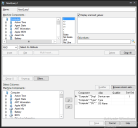About the New query dialog box
The New query dialog box helps you build queries based on inventory data. To access this dialog box, in the Network view click Queries > My queries. Select the query group you want to modify. To modify an existing query, right-click it and click Properties. To create a new query, right-click an existing query group and click New query.
This dialog box has the following functions:
- Name: Identifies the query in query groups.
- Machine components: Lists inventory components and attributes the query can scan for.
- Relational operators: Lists relational operators. These operators determine which description values for a certain component will satisfy the query.
The Like operator is a new relational operator. If a user doesn't specify any wild cards (*) in their query, the Like operator adds wildcards to both ends of the string. Here are three examples of using the Like operator:
Computer.Display Name LIKE "Bob's Machine" queries for: Computer.Display Name LIKE "%Bob's Machine%"
Computer.Display Name LIKE "Bob's Machine*" queries for: Computer.Display Name LIKE "Bob's Machine%"
Computer.Display Name LIKE "*Bob's Machine" queries for: Computer.Display Name LIKE "%Bob's Machine"
- Display scanned values: Lists acceptable values for the chosen inventory attribute. You can also manually enter an appropriate value, or edit a selected value, with the Edit values field. If the selected relational operator is Exists or Does Not Exist, no description values are possible.
- Logical operator: Determines how query statements logically relate to each other:
- AND: Both the previous query statement and the statement to be inserted must be true to satisfy the query.
- OR: Either the previous query statement or the statement to be inserted must be true to satisfy the query.
- Insert: Inserts the new statement into the query list and logically relates it to the other statements according to the listed logical operator. You can't choose this button until you've built an acceptable query statement.
- Edit: Lets you edit the selected query statement. When you're finished making changes, click the Update button.
- Multi-insert: Lets you insert multiple values for a component in the query, rather than selecting values from the list and inserting them one at a time. Paste a list of values into the box and then specify the delimiter that separates the values. Click the Parse button to view the parsed values. If they are correct, click Insert to add the values to your query.
- Delete: Deletes the selected statement from the query list.
- Clear all: Deletes all statements from the query list.
- Query list: Lists each statement inserted into the query and its logical relationship to the other listed statements. Grouped statements are surrounded by parentheses.
- Group (): Groups the selected statements together so they're evaluated against each other before being evaluated against other statements.
- Ungroup: Ungroups the selected grouped statements.
- Filters: Opens the Query Filter dialog box that displays device groups. By selecting device groups, you limit the query to only those devices contained in the selected groups. If you don't select any groups, the query ignores group membership.
- Select columns: Lets you add and remove columns that appear in the query results list for this query. Select a component, and then click the right-arrow button to add it to the column list. You can manually edit the Alias and Sort Order text, and your changes will appear in the query results list.
- Qualifier: The qualifier button is used to limit the results of one-to-many relationships in the database; without it, you will get the same machine listed numerous times in your result set. For example, if you want to see which version of Microsoft Word is installed on every device in your organization, you would insert Computer.Software.Package.Name = 'Microsoft Word' in the query box and select Computer.Software.Package.Version in the Select Columns list. However, simply listing the software version will list every version of every piece of software installed on each device, which you don't want. The solution is to limit (or qualify) the version to only Microsoft Word. Click the Qualify button to insert Computer.Software.Package.Name = "Microsoft Word". This will return only the versions of Microsoft Word.
- Save: Saves the current query. When you save a query before running it, the query is stored in the core database and remains there until you explicitly delete it.
NOTE: Query statements are executed in the order shown
If no groupings are made, the query statements listed in this dialog are executed in order from the bottom up. Be sure to group related query items so they're evaluated as a group; otherwise, the results of your query may be different than you expect.
